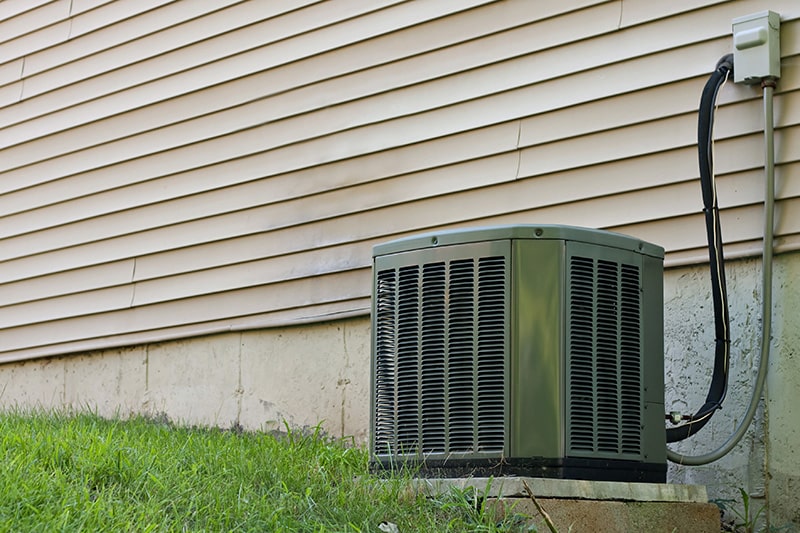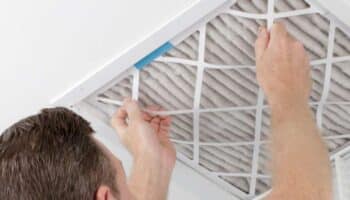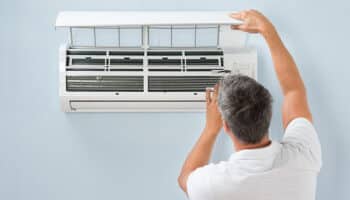We've independently reviewed this article to make sure it's as accurate as we can make it.
To find out more about our article creation and review process, check out our editorial guidelines.
It will cost the average homeowner anywhere from $3,800 to $7,500 to install central air conditioning. And the average lifespan of a central air conditioner is from about 15 to 20 years.
With the way inflation goes, you probably don’t even want to think about what the replacement cost will be 10 years from now. Forget about 15 or 20.
Which leads me to the importance of your central AC maintenance and care. The better you maintain it, the longer it will last. And the more money you can save, long term. And let’s not forget the added benefits of a system that’s running better and more efficiently too.
This guide will walk you through all the steps of maintenance and care for your air conditioner. However, there are some jobs that should only be done by a licensed technician. These will be highlighted, and we ask that you don’t ignore them because mishandling something like a refrigerant is dangerous and can pose serious health threats.
As for the rest of it, I can share my own industry knowledge plus the years of HVAC experience our team of experts brings to the table.
Ready to get your hands dirty?
Let’s go!
Gather Your Gear
Since you’re doing basic maintenance, you’ll only need some basic tools. But you still may need to make a trip to your local hardware store.
- Duct tape—if you discover leaks at duct joins
- Screwdriver
- Air conditioner fin tool
- No-rinse evaporator coil cleaner
- Foaming condenser coil cleaner
- Garden hose with a low-pressure nozzle
- Wet vac
Now you’re ready, so let’s get to work.
Central Air Conditioner Health Check – The Essentials
Your central air conditioner is part of a system, so it’s a good idea to make sure all the peripherals are working as they should. Problems with the AC unit itself will likely show themselves elsewhere.
#1 Unusual Noise
Air conditioners can be loud, especially if you only have a single-stage system that just runs on high all the time. But if you notice strange noises all of a sudden, like banging, clanging, or rattling, this could be a sign of damage somewhere in your system.
Ductwork – If you have access to any visible ductwork, check for damage. If possible, you may also want to get a scope camera and check for something that may have fallen into—or your child has pushed into—your ducts.

Condenser – Your air conditioner’s condenser is outside. If it’s making loud noises, there may be something stuck in the fan, or it may simply be malfunctioning.
Check for any loose parts, tighten them, and/or remove any obstructions.
Blower Fan – The blower fan is inside and is part of your air handler. You’ll find it close to your furnace. Just like the outdoor unit mentioned above, the fan may be loose or malfunctioning.

Tighten the fan if necessary.
#2 Inefficient Cooling
If you discover that your air conditioner is no longer cooling your home as well as it used to, it may be a sign of damage or old age. Wear and tear is normal and air conditioners do have a life cycle, so if you’re pushing your 20-year limit or have gone past it, it may be time to replace your air conditioner.
However, another reason may be leaks or cracks in your ductwork. Finding problems with exposed ductwork is fairly simple, but for anything behind the walls or under the floors, you can rent or purchase duct inspection cameras.
#3 Check Your Energy Bills
This may not be as simple as it once was, as everybody’s energy costs are rocketing skyward. However, if you notice unexplained peaks in your energy costs, it could be an indication that your air conditioner — or furnace — is using more energy than it should.
This could be a sign that your system is in dire need of maintenance or that it’s near or past its life expectancy.
Central Air Conditioner Heathy Check – Follow Good Habits
Your central air conditioner isn’t something you install yourself and hopefully, you hired a reputable HVAC company to do the job.
Despite that, there are several things you can do that will keep your system in good working order.
#1 Outside: Keep Your Condenser Unit Clear
The condenser typically sits a few feet away from your house. Sometimes, you or your kids may be tempted to lean or store things against it.
Please don’t.
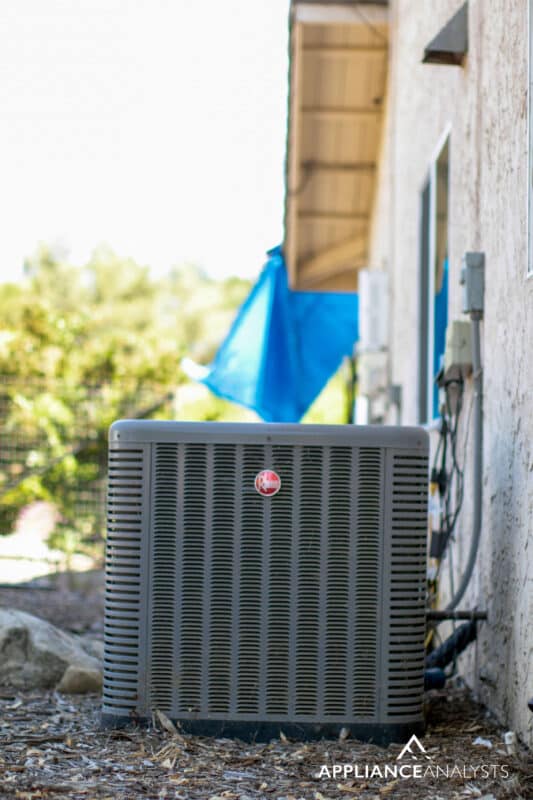
You shouldn’t make a habit of leaning bikes, lawn chairs, toys, or anything else against the outdoor unit. The resulting lack of sufficient airflow can have a negative impact on performance.
This also means doing things like planting bushes or shrubbery or building some sort of enclosure too close or around the unit should be avoided.
#2 Inside: Keep Supply Vents Clear
This means keeping furniture and drapery far enough away from vents so that they’re not blocked.
And if your supply vents tend to get caked up with dust and debris, make sure to keep them vacuumed. Furniture or dust will decrease airflow and reduce efficiency—and decreased airflow can eventually kill your blower motor.
#3 Increase Your Temperature Settings
If you’re not at home, why are you paying to cool your home?
If your family has any sort of regular schedule while you’re all off to work and or school, use a programmable thermostat and allow the temps to increase a few degrees while you’re not home. This can equate to less wear and tear on your system and reduced running costs.
#4 Insulate any Exposed Ductwork
Whether it’s in your attic or your basement, if you have any exposed ductwork, it’s a good idea to insulate it—and seal it if necessary. Once done, your cool air will be heading to where you need it, not leaking out somewhere unnecessary and costing you money.
Central Air Conditioner Health Check – Maintenance
As mentioned at the outset, there are some maintenance tasks that should only be handled by a professional. But there are several—and most of them are very important!—tasks you can handle by yourself.
#1 Change Your Filters
Ironically, regularly changing filters is probably one of the easiest—along with one of the most important—things you need to do regularly. And it’s probably the most overlooked as well.
Depending on the type of filter your system uses, it will have a schedule to either replace or clean. And while you may have a bit of wiggle room with that, you must follow that schedule.
Failure to replace or clean filters can damage your system—so if you’re holding back on replacing because of cost, you’re potentially costing yourself a whole lot more since a lack of airflow could lead to a damaged blower motor.
Air filters that no longer allow air through because of a buildup of dust, dirt, pet hair, or whatever also create an inefficient environment and impact performance.
Even if you don’t immediately need to replace a blower motor or face some other costly repair, you’re making the system work harder to cool your home—meaning you’re using more energy. And you’re probably already feeling the pain of skyrocketing costs every time you get an energy bill. Don’t make it worse!
1. Turn off your air conditioner.
2. Note where the arrow on the filter is positioned and pointing.
3. Carefully remove the old filter.
If it’s washable, immediately place it in a laundry tub or take it outside. Follow the manufacturer’s directions for cleaning. Water and mild soap will typically do.
If you have a replaceable filter, dispose of it.
4. Insert the completely dry—this is very important!—washable filter or the new replacement.
Make sure you replace it in the same position that you noted in Step 1.
#2 Clean the Evaporator Coils
The purpose of the evaporator coil is to absorb the heat from your home. It’s either inside the air handler or attached to your furnace.
If coils get dirt and dust cakes on top of them, their ability to do their job decreases. It will take longer for your home to cool down, which will translate to higher bills. And eventually, they could freeze over entirely.
You can follow the steps in the video above if you need a visual.
1. Turn off your system at the thermostat.
2. Remove the access panel to your air handler—or furnace.
3. Using a no-rinse evaporator coil cleaner, spray down the coils. Be sure to follow the manufacturer’s specific directions.
4. Depending on how badly caked the grime is, you may need to supplement cleaning with a soft brush.
5. When done, replace the panel and turn your system back on.
#3 Clean the Condenser Coil and Repair the Heat Exchanger Fins
As mentioned above in the Follow Good Habits section, it’s important to keep the area around your condenser—the outside unit—clean. But the wind still blows and leaves, twigs, and other debris can fall into the unit.
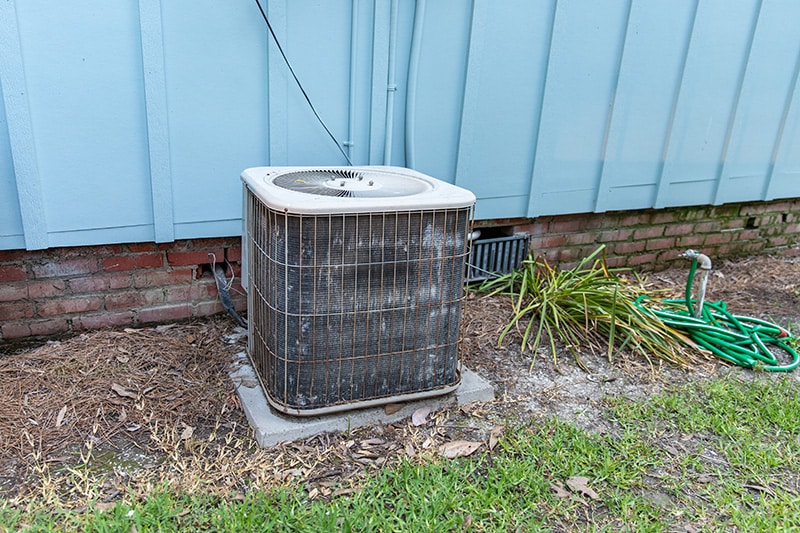
Since you want to protect your investment and preserve the lifespan of your AC, you need to ensure that cleaning your condenser coil is part of your regular annual maintenance.
Here’s how. And again, if you need a visual, please refer to the video above.
1. Turn off your AC at the thermostat or if you have a power breaker at the unit, turn it off there.
2. Use a screwdriver to loosen the bolts that hold the top fan assembly in place.
3. Carefully lift the fan assembly away, but be careful not to damage any wires that are attached to the fan. If they don’t have enough give to pull the fan away, call a pro.
4. Inspect the inside of the unit and remove any debris.
5. If any of the fins are badly bent on the outside of the unit, try using an AC fin tool to straighten them out but note this might not be worth the effort.
6. Using a can of some kind of foaming coil cleaner, spray down the fins on the inner perimeter of the unit and let it sit for about ten minutes.
7. Use a garden hose and hose off the fins from the inside out and then do the same from the outside in. Be sure not to use a high-pressure setting as this can further damage the fins.
8. Replace the fan and fasten it back down.
9. Turn your system back on.
#4 Inspect Your Drain Line for Clogs
If your system smells musty when it’s running, or if you notice water damage or standing water anywhere near the indoor unit, you might have a clog in your condensate drain line.
1. Find your condensate drain pipe on the outside of your home, typically, but not always on the same wall where your furnace is
2. Connect a wet vac to the end of the drain pipe and get an airtight seal
3. Turn on the vacuum and let it run for a minute or two to pull water out of the line. Inspect the water to see if there’s a clump of debris that might have caused a clog.
4. If your drain remains sluggish, the clog still may be there. At this point, my recommendation is to call a pro, but the linked video above does offer some DIY tips. However, it does involve cutting a pipe inside your home.
You’ve Done It!
Whether you’ve followed these steps as preventative maintenance or you worked a bit backward to solve a problem, you’re either keeping your system running at optimal levels or you’ve ensured it will run that way going forward.
You’ve made sure that you have:
- Sufficient airflow—both inside and out—for efficient performance
- A free-flowing condensate drain that will stop the evaporator coil from freezing over
And while there are some things you’ll still need a pro for—for example, anything that involves your refrigerant or refrigerant lines—you can still save on maintenance costs. A well-maintained system will save you on energy costs every year and will push back the day you need to replace your air conditioner.

